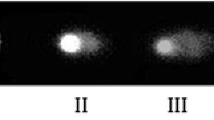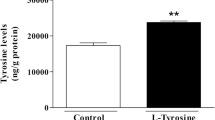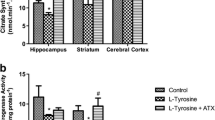Abstract
Tyrosinemia type II, also known as Richner–Hanhart syndrome, is an autosomal recessive inborn error of metabolism caused by a deficiency of hepatic cytosolic tyrosine aminotransferase, and is associated with neurologic and development difficulties in numerous patients. Considering that the mechanisms underlying the neurological dysfunction in hypertyrosinemic patients are poorly known and that studies demonstrated that high concentrations of tyrosine provoke oxidative stress in vitro and in vivo in the cerebral cortex of rats, in the present study we investigate the oxidative stress parameters (enzymatic antioxidant defenses, thiobarbituric acid-reactive substances and protein carbonyl content) in cerebellum, hippocampus and striatum of 30-old-day rats after acute administration of l-tyrosine. Our results demonstrated that the acute administration of l-tyrosine increased the thiobarbituric acid reactive species levels in hippocampus and the carbonyl levels in cerebellum, hippocampus and striatum. In addition, acute administration of l-tyrosine significantly decreased superoxide dismutase activity in cerebellum, hippocampus and striatum, while catalase was increased in striatum. In conclusion, the oxidative stress may contribute, along with other mechanisms, to the neurological dysfunction characteristic of hypertyrosinemia and the administration of antioxidants may be considered as a potential adjuvant therapy for tyrosinemia, especially type II.




Similar content being viewed by others
References
Mitchell GA, Grompe M, Lambert M, Tanguay RM (2001) Hypertyrosinemia. In: Scriver CR, Beaudet AL, Sly WS, Valle D (eds) The metabolic and molecular bases of inherited disease. McGraw-Hill, New York, pp 1977–1982
Buist NR, Kennaway NG, Fellman JH (1995) Tyrosinaemia type II. In: Bickel H, Wachtel V (eds) Inherited diseases of aminoacid metabolism, 1st edn. Georg Thieme Verlag, Stuttgart, pp 203–235
Light IJ, Sutherland JM, Berry HK (1973) Clinical significance of tyrosinemia of prematurity. J Inherit Metab Dis 12:13–22
Mamunes P, Prince PE, Thornton NH, Hunt PA, Hitchcock ES (1976) Intellectual deficits after transient Mediators Inflamm 7:239–255
Sener RN (2005) Tyrosinemia-computed tomography, magnetic resonance imaging, diffusion magnetic resonance imaging, and proton spectroscopy findings in the brain. J Comput Assist Tomogr 29:323–325
Sgaravatti AM, Magnusson AS, de Oliveira AS, Rosa AP, Mescka CP, Zanin FR, Pederzolli CD, Wyse AT, Wannmacher CM, Wajner M, Dutra-Filho CS (2009) Tyrosine administration decreases glutathione and stimulates lipid and protein oxidation in rat cerebral cortex. Metab Brain Dis 24:415–425
Sgaravatti AM, Vargas BA, Zandoná BR, Deckmann KB, Rockenback FJ, Moraes TB, Monserrat JM, Sgarbi MB, Pederzolli CD, Wyse ATS, Wannmacher CMD, Wajner M, Dutra-Filho CS (2008) Tyrosine promotes oxidative stress in cerebral cortex of young rats. Int J Dev Neurosci 26:553–559
de Andrade RB, Gemelli T, Rojas DB, Funchal C, Dutra-Filho CS, Wannmacher CM (2011) Tyrosine inhibits creatine kinase activity in cerebral cortex of young rats. Metab Brain Dis 26:221–227
de Andrade RB, Gemelli T, Rojas DB, Funchal C, Dutra-Filho CS, Wannmacher CM (2012) Tyrosine impairs enzymes of energy metabolism in cerebral cortex of rats. Mol Cell Biochem 364:253–261
Halliwell B (1994) Free radicals, antioxidants and human disease: curiosity, cause or consequence? Lancet 344:721–724
Halliwell B (2001) Role of free radicals in the neurodegenerative diseases: therapeutic implications for antioxidant treatment. Drugs Aging 18:685–716
Reznick AZ, Parker L (1993) Free radicals and antioxidants in muscular neurological diseases and disorders. In: Poli G, Albano E, Dianzani MU (eds) Free radicals: from basic science to medicine. Birkäuser Verlag, Basel, pp 425–437
Przedborski S, Donaldson DBS, Jakowec M, Kish SJ, Guttman M, Rosoklija G, Hays AP (1996) Brain superoxide dismutase, catalase and glutathione peroxidase activities in amyotrophic lateral sclerosis. Ann Neurol 39:158–165
Ben-Menachem E, Killerman R, Markleind S (2000) Superoxide dismutase and glutathione peroxidase function in progressive myoclonus epilepsies. Epilepsy Res 40:29–33
Slotkin TA, Oliver CA, Seidler FJ (2005) Critical periods for the role of oxidative stress in the developmental neurotoxicity of chlorpyrifos and terbutaline, alone or in combination. Brain Res Dev Brain Res 157:172–180
Halliwell B, Gutteridge JMC (2007) Measurement of reactive species. In: Halliwell B, Gutteridge JMC (eds) Free radicals in biology and medicine, 4th edn. Oxford University Press, Oxford, pp 268–340
Halliwell B (1991) Reactive oxygen species in living systems: source, biochemistry, and role in human disease. Am J Med 91:14S–22S
Yu BP (1994) Cellular defenses against damage from reactive oxygen species. Physiol Rev 74:139–162
Bannister JV, Bannister WH, Rotilio G (1987) Aspects of the structure, function and applications of superoxide dismutase. CRC Crit Rev Biochem 22:111–180
Bongiovanni R, Yamamoto BK, Simpson C, Jaskiw GE (2003) Pharmacokinetics of systemically administered tyrosine: a comparison of serum, brain tissue and in vivo microdialysate levels in the rat. J Neurochem 87:310–317
Morre MC, Hefti F, Wurtman RJ (1980) Regional tyrosine levels in rat brain after tyrosine administration. J Neural Transm 49:45–50
Held PK (2006) Disorders of tyrosine catabolism. Mol Genet Metab 88:103–106
Lowry OH, Rosebough NG, Farr AL, Randall RJ (1951) Protein measurement with the Folin phenol reagent. J Biol Chem 193:265–275
Draper HH, Hadley M (1990) Malondialdehyde determination as index of lipid peroxidation. Methods Enzymol 186:421–431
Levine RL, Williams JA, Stadtman ER, Shacter E (1994) Carbonyl assays for determination of oxidatively modified proteins. Methods Enzymol 233:346–357
Bannister JV, Calabrese L (1987) Assays for superoxide dismutase. Methods Biochem Anal 32:279–312
Aebi H (1984) Catalase in vitro. Methods Enzymol 105:121–126
Marklund SL (1985) Pyrogallol autoxidation. In: Greenwald RA (ed) Handbook of Methods for Oxygen Radical Research, CRC Press Inc, pp 243–247
Bird S, Miller NJ, Collins JE, Rice-Evans A (1995) Plasma antioxidant capacity in two cases of tirosinaemia type 1: one case treated with NTBC. J Inherit Metab Dis 18:123–126
Colome C, Sierra C, Vilaseca MA (2000) Congenital errors of metabolism: cause of oxidative stress? Med Clin 115:111–117
Latini A, Ferreira CG, Scussiato K, Schuck PF, Dutra-Filho CS, Vargas CR, Wajner M (2007) Induction of oxidative stress by chronic and acute glutaric acid administration to rats. Cell Mol Neurobiol 27:423–438
Sitta A, Barschak AG, Deon M, Terroso T, Pires R, Giugliani R, Dutra-Filho CS, Wajner M, Vargas CR (2006) Investigation of oxidative stress parameters in treated phenylketonuric patients. Metab Brain Dis 20:287–296
Streck EL, Vieira PS, Wanmacher CM, Dutra-Filho CS, Wajner M, Wyse AT (2003) In vitro effect of homocysteine on some parameters of oxidative stress in rat hippocampus. Metab Brain Dis 18:147–154
Wajner M, Latini A, Wyse ATS, Dutra-Filho CS (2004) The role of oxidative damage in the neuropathology of organic acidurias: insights from animal studies. J Inherit Metab Dis 27:427–448
Barschak AG, Sitta A, Deon M, Oliveira MH, Haeser A, Dutra-Filho CS, Wajner M, Vargas CR (2006) Evidence that oxidative stress is increased in plasma from patients with maple syrup urine disease. Metab Brain Dis 21:279–286
Stadtman ER, Levine RL (2003) Free radical-mediated oxidation of free amino acids and amino acid residues in proteins. Amino Acids 25:207–218
Scott CR (2006) The genetic tyrosinemias. Am J Med Genet C Med Genet 142:121–126
Stoerner JW, Butler IJ, Morriss FH Jr, Howell RR Jr, Seifert WE Jr, Caprioli RM, Adcock EW, Denson SE (1980) CSF neurotransmitter studies. An infant with ascorbic acid-responsive tyrosinemia. Am J Dis Child 134:492–494
Schmidt RH, Bhatnagar RK (1979) Assessment of the effects of neonatal subcutaneous 6-hydroxydopamine on noradrenergic and dopaminergic innervation of the cerebral cortex. Brain Res 166:309–319
Jana S, Sinha M, Chanda D, Roy T, Banerjee K, Munshi S, Patro BS, Chakrabarti S (2011) Mitochondrial dysfunction mediated by quinone oxidation products of dopamine: implications in dopamine cytotoxicity and pathogenesis of Parkinson’s disease. Biochim Biophys Acta 1812:663–673
Moriarty-Craige SE, Jones DP (2004) Extracellular thiols and thiol/disulfide redox in metabolism. Annu Rev Nutr 24:481–509
Acknowledgments
This study was supported by grants from Conselho Nacional de Pesquisa e Desenvolvimento (CNPq), Fundação de Apoio à Pesquisa Científica e Tecnológica do Estado de Santa Catarina (FAPESC) and Universidade do Extremo Sul Catarinense (UNESC).
Author information
Authors and Affiliations
Corresponding author
Rights and permissions
About this article
Cite this article
Macêdo, L.G.R.P., Carvalho-Silva, M., Ferreira, G.K. et al. Effect of Acute Administration of l-Tyrosine on Oxidative Stress Parameters in Brain of Young Rats. Neurochem Res 38, 2625–2630 (2013). https://doi.org/10.1007/s11064-013-1180-3
Received:
Revised:
Accepted:
Published:
Issue Date:
DOI: https://doi.org/10.1007/s11064-013-1180-3




